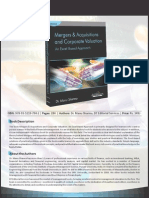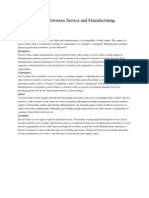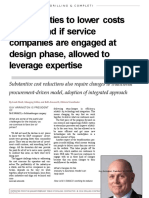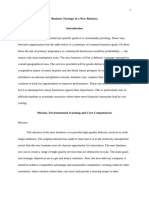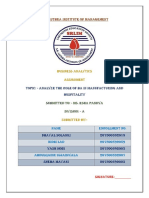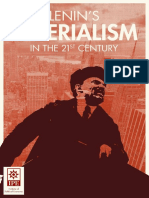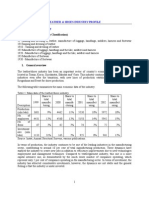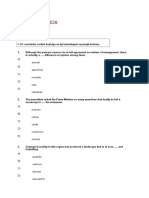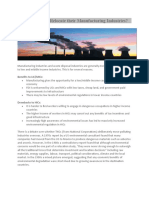Master of Business Administration - MBA Semester 2 MB 0044 - Production and Operation Management (4 Credits) (Book ID:B1627) Assignment
Master of Business Administration - MBA Semester 2 MB 0044 - Production and Operation Management (4 Credits) (Book ID:B1627) Assignment
Uploaded by
Vikas WaliaCopyright:
Available Formats
Master of Business Administration - MBA Semester 2 MB 0044 - Production and Operation Management (4 Credits) (Book ID:B1627) Assignment
Master of Business Administration - MBA Semester 2 MB 0044 - Production and Operation Management (4 Credits) (Book ID:B1627) Assignment
Uploaded by
Vikas WaliaOriginal Description:
Original Title
Copyright
Available Formats
Share this document
Did you find this document useful?
Is this content inappropriate?
Copyright:
Available Formats
Master of Business Administration - MBA Semester 2 MB 0044 - Production and Operation Management (4 Credits) (Book ID:B1627) Assignment
Master of Business Administration - MBA Semester 2 MB 0044 - Production and Operation Management (4 Credits) (Book ID:B1627) Assignment
Uploaded by
Vikas WaliaCopyright:
Available Formats
Master of Business Administration - MBA Semester 2 MB 0044 - Production and Operation Management (4 credits) (Book ID:B1627 ) ASSIGNMENT- Set 1
Q1. Explain the basic competitive priorities considered while formulating operations strategy by a firm? Ans: Competitive Priorities The key to developing an effective operations strategy lies in understanding how to create or add value for customers. Specifically, value is added through the competitive priority or priorities that are selected to support a given strategy. Skinner and others initially identified four basic competitive priorities. These were cost, quality, delivery ,and flexibility.These four priorities translate directly into characteristics that are used to describe various processes by which a company can add value to the products it provides. There now exists a fifth competitive priority service and it was the primary way in which companies began to differentiate themselves in the 1990s.Cost Within every industry, there is usually a segment of the market that buys strictly on the basis of low cost. To successfully compete in this niche, a firm must necessarily, therefore be the low-cost producer. But, as noted earlier, even doing this doesnt always guarantee.Profitability and success .Products sold strictly on the basis of cost are typically commodity-like. (Examples of commodities include flour, petroleum, and sugar.) In other words, customers cannot easily distinguish the products made by one firm from those of another. As a result, customers use cost as the primary determinant in making a purchase. Quality Quality can be divided into two categories: product quality and process quality. The level of quality in a products design will vary as to the particular market that it is aimed to serve. Obviously, a childs first two-wheel bicycle is of significantly different quality than the bicycle of a world-class cyclist. The use of thicker sheet metal and the application of extra coats of paint are some of the product quality characteristics that differentiate a Mercedes-Benz from a Hyundai. One advantage of offering higher-quality products is that they command higher prices in the marketplace. The goal in establishing the proper level of product quality is to focus on the Requirement of the customer. Overdesigned products with too much quality will be viewed as being prohibitively expensive. Under designed products, on the other hand, will lose customers to products that cost a little more but are perceived by the customers as offering much greater benefits.Delivery Another market niche considers speed of delivery to be an important determinant in its purchasing decision. Here, the ability of a firm to provide consistent and fast delivery allows it to charge a premium price for its products. George Stalk Jr., of the Boston Consulting Group, has demonstrated that both profits and market share are directly linked tot he speed with which a company can deliver its products relative to its competition.11 In addition to fast delivery, the reliability of the delivery is also important. In other words, products should be delivered to customers with minimum variance in delivery times. Flexibility From a strategic perspective, in terms of how a company competes, flexibility consists of two dimensions, both of which relate directly to how the f irms processes are designed. One element of flexibility is the firms ability to offer its customers a wide variety of Products. The greatest flexibility along this dimension is achieved when every product is customized to meet the specific requirements of each individual customer. This is often referred to as mass customization.. i. The ability to change the volume of production ii. The ability to change the time taken to produce. iii.The ability to change the mix of different products or services produced. iv.The ability to innovate and introduce new products and services. Q2. a. List the benefits of forecasting b. Explain the significance of plant location decision Ans :BENEFITS OF FORECASTING Good forecast of material, labor and other resources for operation are essentially needed by the managers. If good projection of future demand is available, the management may take suitable action regarding inventory. Similarly, if production activities are accurately forecasted, then balanced work-load may be planned. Good labor relations may bemaintained, as there would be lesser hiring and firing activities by the management withbetter manpower planning. Therefore, forecasting is useful due to following benefits: 1.Effective handling of uncertainty 2.Better labor relations 3.Balanced work-load 4.Minimization in the fluctuations of production 5.Better use of production facilities 6.Better material management 7.Better customer service 8.Better utilization of capital and resource 9.Better design of facilities and production system.
Efforts in forecasting activity involve two types of costs. While more effort in fore castingcauses increased cost due to data collection and analysis; lesser forecasting activity involves lost revenue, which may be due to unplanned labor, unplanned material or unplanned capital cost. Therefore, each firm should maintain a balance in its forecasting effort and stick to a zone near to accuracy cost trade off. B .Explain the significance of plant location decision.\ Ans: significance of Plant location: The strategic significance of facility location is connected with capacity decisions. Indeed ,the issue of capacity expansion immediately raises the companion issue of where to expand in order to tie in effectively with the distribution network. We have separated the materials into two areas because the approaches to the sub-problems are quite different and to divide the materials into manageable units. The location of facilities involves a commitment of resources to a long-range plan. Thus, predictions of the size and location of markets are of great significance. Given these predictions, we establish facilities for production and distribution that require large financial outlays. In manufacturing organizations, these capital assets have enormous value, and even in service organizations, the commitment of resources may be very large. Location and distribution take on even greater significance because these plans represent the basic strategy for accessing markets and may have significant impacts on revenue, costs, and service levels to customers and clients .It is not immediately obvious that location is a dominant factor in the success or failure of an enterprise. Indeed, it is not uniformly important for all kinds of enterprises. Decentralization within industries must mean that many good locations exist or that the location methods used could not discriminate among alternative locations. General technological constraints will commonly eliminate most of the possible locations. Or, to take the opposite point of view, a technological requirement may dominate, so that activity is then oriented toward the technical requirement. For example, mining is raw material oriented, beer is water oriented, aluminum reduction is energy oriented, and service activities, including sales, are consumer or client oriented in their locations. If some technological requirements, such as the location of raw materials, water, or energy, does not dominate, then manufacturing industries are often transportation oriented. The criterion for the choice of location should be profit maximization for economic activities .If the prices of products are uniform in all locations, then the criterion becomes one of minimizing relevant costs .If the costs of all inputs are independent of location, but product prices vary, then the criterion for location choice becomes maximum revenue. In such instances, locations will gravitate to the location of consumers, and the general effect will be to disperse order centralize facilities. If all
processes and costs are independent of location then choice will be guided by proximity to potential customers or clients or to similar and competing organizations and to centers of economic activity in general. A plant should be located at a place where the inhabitant s are interested in its success, the product can be sold are interested in its success, the product can be sold profitably and the production cost is minimum. Profitably and the production cost is minimum .According to Dr .Visvesvarirya the decision of plant location According to Dr. Visvesvarirya the decision of plant location should be based on nine Ms ,namely should be based on nine Ms, namely MONEYMONEY,MATERIALMATERIAL,MANPOWERMANPOWER,MARKETMARKET,MOTIVEMOTIVE,MANAGEM ENT (POWER) MANAGEMENT (POWER),MACHINERYMACHINERY,MEANS OF COMMUNICATIONMEANS OF COMMUNICATION,MOMENTUM TO AN EARLY STARTMOMENTUM TO AN EARLY START Q3 what do you understand by line balancing? What happens if balance doesnt exist? Ans: Here is a simple definition and example of line balancing: Everyone is doing the same amount of work Doing the same amount of work to customer requirement, Variation is smoothed, No one overburdened,No one waiting, Everyone working together in a BALANCED fashion Description Line Balancing is leveling the workload across all processes in a cell or value stream to remove bottlenecks and excess capacity. A constraint slows the process down and results if for downstream operations and excess capacity results in waiting and absorption of fixed Costs. Objective Match the production rate after all wastes have been removed to the takt time at each process of the value stream. EXAMPLE: Taking the example from thepage as the starting point there were additional studies conducted each the remaining processes that it takes to make UNIT ABC. There are five processes in the work cell dedicated to only UNIT ABC. Each process has same demand and Available work time=same takt time. The LOADING data was found using historical production data of ACCEPTABLE parts only including downtime but only when the processes were scheduled with operator(s).The customer only wants acceptable parts and that is what the customer demand is based on within the takt time formula. When figuring the production rates (loading) the scrap or non-conforming pieces must be netted out. Process 1: Taking much longer thanOvertime is probably used to make up production and is the #1 constraint. Process 2: Exceeding the probably a lot of waiting and the excess capacity can be filled by absorbing some of the work from Process 1 and/or Process 3 & 5: Very close to meeting not a focus area but possibly some best practices and application of LEAN tools can improve these loading rates. Improvement in these areas could be used to share workload from constraint processes. Process 4: Taking longer than Again, overtime is probably used or there are late deliveries, high expediting costs or unhappy customers. Apply principles and Try to alleviate workload to Process 2 or others that may be able be improved to absorb some of the workload. After Line Balancing: Visual Management tools were added to reduce complexity and improve consistency of units produced. Standard operating procedures and training were done for all operators. SMED activity was done on all operations with focus on Process 1. Point-of-use tooling and shadow boards were implemented. Kanbans were established for materials. Some steps in each process were no longer required as former paradigms and rules were challenged. The machines in a couple operations received upgrades and overdue minor rebuild and were added to a TPM program. There speeds were dramatically improved (the "performance" component of OEE) Error-proof jig to prevent defects and rework was implemented. And/on lights were added as communication signals.
Q4.Describe the various approaches to TQM? Ans: Approaches of Total Quality Management (TQM), you have to evaluate which methods best suit your company and your management style. The term came from the teachings of the late statistician and industrial consultant, W. Edwards Deming, who promoted five basic principles: Reduce errors that occur during the manufacture or presentation of a product or service.Render efficiency among the components (staff or company departments) necessary to produce the product or service. Utilize the most modern equipment or procedures available. Maintain constant levels of employee training and education. Assess levels of customer satisfaction. TQM is an integrated management philosophy and a set of practices that emphasize continuous improvement, meeting customer requirements, reducing rework, long-range thinking, increased employee involvement and teamwork, process redesign, competitive benchmarking, team-based problem solving, constant measurement of results, and closer relationships with suppliers (Ross, 1993). Using TQM in manufacturing will result in a number of improvements, including increased profits, more satisfied customers, and better business practices in general.TQM is broken down into the following shortening: T - Total = involvement from everyone at the company Q - Quality = the standard in which you define product perfection M - Management = the system of managing the different steps of the business management strategy Primary Elements of TQM: (i) Top management has to demonstrate its commitment to TQM and provide strategic direction to the movement strategic outlook. (ii) Customer involvement/satisfaction, customer driven quality. (iii) Shares vision (suppliers/vendors, employees, employer) partnership. (iv) Process orientation process ownership. (v) Team work consensus. (vi)Products and services to be delivered at lowest social cost. (vii) Cultural change at all levels.(viii) Employees Empowerment. (ix) Innovation is must for survival. (x) System thinking has to be development.Approches: (i) Dc buffering, Quality circle, Total quality control, JIT, SPC (ii) Scientific styling, Robust design, off line quality control, High technology circle, Total preventive maintenance, Statistical and management tools. (iii) Whole work force deployment, new technology deployment, Policy deployment ,Automation deployment (iv) Process Engineering, Process improvement, Process execution automation, Process architecting, Process deployment automation.
Benefits of quality control are: (i) builds an information system for improving quality and reducing the cost. (ii) Increased production under the optimum conditions. (iii) Reduction in scrap. (iv) Quality consciousness. (v) Fewer customer complaints. Q5.a. What is meant by productivity? Explain. Ans Productivity is a measure of the efficiency of production. Productivity is a ratio of production output to what is required to produce it (inputs). The measure of productivity is defined as a total output per one unit of a total input. Production Management encompasses all activities which go into conversion of a set of inputs into outputs which are useful to meet human needs. It involves the identification of the requisite materials, knowledge of the processes, and installation of equipments necessary to convert or transform the materials to products. The quantities to be produced have to be ascertained, processes established, specifications detailed out, quality maintained and products delivered in time to meet the demands. Capital Productivity Capital deployed in plant, machinery, buildings and the distribution system as well as working capital is components of the cost of manufacture and need to be productive. Demand fluctuations, uncertainties of production owing to breakdowns and inventories being created drag the productivity down. Therefore, strategies are needed to maximize the utilization of the funds allotted towards capital. Adapting to new technologies: 1. Outsourcing Strategies- When capacity requirements are determined it will be easy to determine whether some goods or services can be outsourced so that the capital and manpower requirements can be reduced and the available capacities are used to augment core competencies thus reducing the cost of the product or service to the customer. However, the following factors may restrict outsourcing(a) Lack of expertise the outsourced firm may not have the requisite expertise to do the job. Required,(b) Quality considerations Loss of control over operations may result in lower quality. This is a risk that the firm gets exposed to. (c) Nature of demand When the load is uniform and steady, it may not be worthwhile to outsourcing. Absence of supervisions and control may be a hindrance to meet any urgent requirements of the customer. This affects the business especially if no production facilities are built in the organization.(d) Cost when the fixed costs that goes along with making the product does not get reduced considerably 2. Methods Improvement-Methods Improvement starts with Methods analysis focus of this process is how a job is done breaking it down to elemental tasks so that they are amenable for analysis.. This is done for both running jobs and new jobs. For a new job, the description becomes the input for analysis. For current jobs, the analyst depends on observations, records and suggestions of the persons involved in the job. When improved methods are suggested, they are implemented and records created for assessing the consequences of the methods improvement procedures. The analyst should involve all concerned persons in the process so that acceptance becomes possible and opportunities open up for further improvements. Moreover, the people actually involved would be interested in improving their productivity and will help the analyst in the process.
3 Balancing of Workstations-Assembly lines necessitate out stringing together workstations which carry out operations in a sequence so that the product gets completed in stages. Since the workflow has to be uniform and operations may require different periods for completion the necessity of Line Balancing is felt. Capacities at workstations and the workforce to man are so adjusted that a product in the process of assembly almost approximately the same amount of time. 4. Rationalization of Packaging Methods-With logistics becoming an important function of the supply chain and outsourcing becoming the norm, packaging has become an important aspect, packaging has become important .Space is at a premium and therefore stacking and storing have to more scientific. Movements inside the premises from one location to another location are being done with automated systems and they need that the packaging systems are designed for safe transit, continuous Monitoring Both for quantities and operations. In case of outsourced products the materials Used and their design should facilitate reuse of the same which brings in economy. B. What do you mean by operations strategy? Explain in brief. Ans: Obviously operations strategy is a huge subject. And although this textbook takes a slightly more strategic view than most books in the area, Chapter 3 only scratches the surface of the subject. The first part of the chapter (the larger part) looks at the content of Operations strategy by taking four, quite distinct perspectives. The second part of the chapter looks at the process of operations strategy, mainly by describing two relatively well-known processes for devising an operations strategy. Top-down versus bottom-up perspectives of operations strategy One view of operations strategy (the more traditional one) is operations strategy is one of several Functional strategies which are governed by decisions taken at the top of the Organizational tree. According to this top-Down approach, overall business strategy sets the general direction of the organization, this is then interpreted by the different functional areas of the company (marketing, finance, operations, etc.) in their functional strategies. By contrast, the bottom-up view of operations strategy is to see strategic decision making as an Accumulation of practical experiences. After all, organizations would find it difficult to invent strategies in a total vacuum. Their ideas are formed from their previous experience of Dealing with customers, suppliers and their own processes. This is the idea behind Emergent strategies These are strategic ideas which emerge over time as an organization begins to understand the realities of their situation. When thinking about top-down versus bottom-up perspectives of operations strategy, remember that they are not rivalideas. In reality we can see both top-Down and bottom-up Influences on strategy making. What is important to remember is that the pure top down View of operations strategy is simplistic in the sense that it does not recognize the importance of learning through experience.Market requirements versus operations resources.The chapter goes on to propose another apparent clash of perspectives That between market requirements and operations resources. Again, it is a comparison between what has been the orthodox view (market requirements perspective) and what is a more recent view (the operations resource perspective). Again also, it is not a real clash in the sense that neither perspective is right or wrong. The market requirements perspective starts from the commonsense notion that any operations strategy should reflect what the organization is trying to do in its markets. Companies compete in different ways; some may compete primarily on cost, others on the excellence of their products or services, others on high levels of customer service, others on customisingtheir products and services to individual customer needs, and so on. The operations function therefore must respond to this by providing the capabilities which allow it perform in an appropriate manner to satisfy the requirements of its market. In some ways this is atranslationtask because the techniques and language used by marketing managers to Understand the requirements of markets are different to the language and techniques used by operations managers to manage their productive resources. So, for example, Figure 3.6 shows How competitive factors can be translatedinto performance objectives. Different ways of Competing imply different competitive factors and therefore different performance objectives. Table 3.1 gives an example of how this translation process works in the banking industry. Seethe figure below for another example. It describes and instrument manufacturer with two product groups. The first product group is a range of standard electronic medical equipment which is sold off the shelfdirect to Hospitals and clinics. The second product group is a wider range of electronic measuring devices which are sold to original equipment manufacturers that incorporate them in their own products. These electronic measuring devices often have to be customized to individual customer requirements.
The analysis of the two product groups shows that they have very different competitive factors. Therefore different performance objectives are required from the manufacturing operation. Such very different competitive needs could possibly require two separate operations one for each product group each focused on its own objectives and devoted to providing the things which are important in its particular markets.
Operations strategy influences performance objectives To some extent all the decisions made in all strategy areas will exert some influence on all the performance objectives of the operation. Some strategies, however, are particularly influential on certain objectives. The table below highlights those objectives which will be particularly influenced by each strategy (though remember that the important links between strategies and objectives will to some extent depend on the type of operation and the circumstances in which it finds itself). Strategies with a particularly significant effect on particular performance objectives The process of operations strategy The final part of the chapter illustrates two processes, the Hill methodology and the Platts-Gregory procedure. Both have similarities but neither claims to be a complete answer, or how to do itprocess. When reading about these two processes bear in mind that they are both primarily market requirementsdriven.
Q6. What is logical process modelling? What is physical modelling? Logical Process Modelling Logical Process Modeling is the representation of putting together all the activities of business process in details and making a representation of them. The initial data collected need to be arrange in a logical manner so that, links are made between nodes for making for the workflow smooth. The steps to be followed to make the work smoother are given below: 1. Capture relevant data in detail to be acted upon.2. Establish controls and limit access to the data during processes execution3. Determine which task in the process is to be done and also the subsequent task in that process.4. Make sure that all the relevant data is available for all the tasks.5. Make the relevant and appropriate data available for that task.6. Establish a mechanism to indicate acceptance of the results after every task or process. This is to have an assurance that flow is going ahead with accomplishments in the desired path. Some of these activities may occur in a sequential order whereas; some of them run parallel. There may even be circular paths, like re-work loops. Complexities arise when the processes activities are not connected together. Logical processes model consists of only the business activities and shows the connectivity among them. The process model is a representation of the business activities different from the technology dependent ones. Thus, we have a model that is singularly structured only for business activities. Computer programmes are also present in the total system. This allows the business oriented executives to be in control of the inputs, processes and outputs. The logical process model Improves, control on the access to data. It also indentifies, who is in possession of data at different nodes in the dataflow network that has been structured. A few of the logical modeling formats are given below. 1. Process Descriptions with task sequences and data addresses2. Flow chart with various activities and relationships3. Flow diagrams4. Function hierarchies5. Function dependency diagram Every business activity, when considered as a logical process model, can be represented by a diagram, it can be decomposed and meaningful names can be given to the details. Verb and noun form combinations can be used to describe at each level. Nouns give the name of the activity uniquely and are used for the entire model meaning the same activity. PHYSICAL PROCESS MODELLING Physical process modeling is concerned with the actual design of data base meeting the requirement of the business. Physical modeling deals with the conversion of the logical model into a relation model. Object gets defined at the schema level. The objects here are tables created on the basis of entitiesand attributes. A database is defined for the business. All the information is put together to make the database software specific. This means that the objects during physical modeling vary on the database software being used. The outcomes are server model diagrams showing tables and relationships with a database.
You might also like
- HBR's 10 Must Reads on Strategy (including featured article "What Is Strategy?" by Michael E. Porter)From EverandHBR's 10 Must Reads on Strategy (including featured article "What Is Strategy?" by Michael E. Porter)Rating: 4.5 out of 5 stars4.5/5 (26)
- 4 V's of OperationDocument6 pages4 V's of OperationRahul Agarwal85% (20)
- Mergers & Acquisitions and Corporate ValuationDocument2 pagesMergers & Acquisitions and Corporate ValuationDreamtech Press0% (1)
- Task No. 4Document4 pagesTask No. 4VenNo ratings yet
- Fall 2022-2023 - Engineering Management - Chapter 2 - Competitiveness and ProductivityDocument36 pagesFall 2022-2023 - Engineering Management - Chapter 2 - Competitiveness and Productivityvajojo8727No ratings yet
- First Six Pages - SAMPLE - HSC Business Studies Syallabus Revision GuideDocument6 pagesFirst Six Pages - SAMPLE - HSC Business Studies Syallabus Revision GuideJessica SamNo ratings yet
- Five Differences Between Service and Manufacturing OrganizationsDocument6 pagesFive Differences Between Service and Manufacturing Organizationsullaschaudhari100% (3)
- Operations Management: Individual Assignment (20%)Document7 pagesOperations Management: Individual Assignment (20%)AddiNo ratings yet
- Assignment Answers Operations ManagementDocument7 pagesAssignment Answers Operations ManagementAnkitNo ratings yet
- 02 VistasDocument56 pages02 VistasfadligmailNo ratings yet
- HSC Business Studies Syllabus Revision GuideDocument96 pagesHSC Business Studies Syllabus Revision GuideEdward Pym100% (3)
- MB 0044 AssignmentDocument7 pagesMB 0044 Assignmentrana_dipaNo ratings yet
- Competitive DimensionsDocument5 pagesCompetitive DimensionsChâu YênNo ratings yet
- Chapter 6 Performance Objectives of Operations ManagementDocument17 pagesChapter 6 Performance Objectives of Operations ManagementJimmy Ong Ah Huat100% (2)
- Operations and Supply Chain ManagementDocument15 pagesOperations and Supply Chain ManagementHaba Saba100% (1)
- Strategic Development in Hospitality: Lesson 1Document26 pagesStrategic Development in Hospitality: Lesson 1Yeunna LaurenNo ratings yet
- Operation & Supply Strategy: Price, Value Goes Way UpDocument3 pagesOperation & Supply Strategy: Price, Value Goes Way UpMinhaz UddinNo ratings yet
- Integrated Solutions DCDocument5 pagesIntegrated Solutions DCAlexVillagómezJacomeNo ratings yet
- Peration ManenemtDocument8 pagesPeration ManenemtCool BuddyNo ratings yet
- The Seven Keys To World-Class ManufacturingDocument8 pagesThe Seven Keys To World-Class ManufacturingSherif El-SherifNo ratings yet
- What Is StrategyDocument93 pagesWhat Is StrategySaad AhmedNo ratings yet
- Assignment Unit 4 Capacity PlanningDocument10 pagesAssignment Unit 4 Capacity PlanningPriyank LashkariNo ratings yet
- Target CostingDocument32 pagesTarget Costingapi-3701467100% (3)
- Business Strategy of A New BusinessDocument8 pagesBusiness Strategy of A New BusinessSanjay PotterNo ratings yet
- Disha School of Management Assignment ofDocument7 pagesDisha School of Management Assignment ofRajeesh NairNo ratings yet
- BA Group No - 10.Document39 pagesBA Group No - 10.Mavani snehaNo ratings yet
- Dissertation Target CostingDocument7 pagesDissertation Target CostingPaperWritingServiceCheapCanada100% (1)
- Target Costing Research PaperDocument5 pagesTarget Costing Research Paperl1wot1j1fon3100% (1)
- Operations MGT Module #8Document3 pagesOperations MGT Module #8Jude VicenteNo ratings yet
- Dmba 206Document10 pagesDmba 206ms9781077No ratings yet
- Operations Strategy and Competitiveness (Assignment # 2) : PriceDocument5 pagesOperations Strategy and Competitiveness (Assignment # 2) : PriceSheila Mae LiraNo ratings yet
- Cost Analysis Through Life Cycle Analysis and Target CostingDocument35 pagesCost Analysis Through Life Cycle Analysis and Target CostingSunny KhsNo ratings yet
- 1-Ans. Competitiveness Is at The Core of All Strategies. Even Among Them, Priorities Tend ToDocument5 pages1-Ans. Competitiveness Is at The Core of All Strategies. Even Among Them, Priorities Tend Toajayabhi21No ratings yet
- MGT411-Business Strategy Assignment: DATE 15-12-2019Document7 pagesMGT411-Business Strategy Assignment: DATE 15-12-2019santosh vighneshwar hegdeNo ratings yet
- MGT411 Business StrategyDocument4 pagesMGT411 Business Strategyprashant jain100% (1)
- 19mbaj0190 Sri Sai Aditya Sec D Activity 1Document5 pages19mbaj0190 Sri Sai Aditya Sec D Activity 1YASEEN AKBARNo ratings yet
- Profit 22Document15 pagesProfit 22nagamuniNo ratings yet
- Supply-Chain and Logistics Management FOR Creating A Competitive Edge Part OneDocument21 pagesSupply-Chain and Logistics Management FOR Creating A Competitive Edge Part OneNixon PatelNo ratings yet
- The Utilization of Target Costing in The Telecom IndustryDocument6 pagesThe Utilization of Target Costing in The Telecom IndustryThe IjbmtNo ratings yet
- Guidelines For Business PlanDocument4 pagesGuidelines For Business PlanJetsson SoNo ratings yet
- Operations Management Thesis TitleDocument8 pagesOperations Management Thesis Titleannemarieolathe100% (1)
- Operation Management - LocationDocument23 pagesOperation Management - Locationakshat srivastavaNo ratings yet
- MB 0044Document8 pagesMB 0044veerakaur604No ratings yet
- Operation Management Assignment - 1Document10 pagesOperation Management Assignment - 1defender DhimanNo ratings yet
- Warehouse Operation Management ReportDocument24 pagesWarehouse Operation Management ReportClinton SamsonNo ratings yet
- 6 Strategic Practices in Business: 6.1 GlobalizationDocument14 pages6 Strategic Practices in Business: 6.1 GlobalizationSeb BazerqueNo ratings yet
- Target Costing For CompaniesDocument6 pagesTarget Costing For CompaniesWill EdwardNo ratings yet
- Module 2 (Operations Strategy and Competitiveness)Document9 pagesModule 2 (Operations Strategy and Competitiveness)Jayzell MonroyNo ratings yet
- Module 1 (Introduction To Strategic Operations Management)Document5 pagesModule 1 (Introduction To Strategic Operations Management)Jayzell MonroyNo ratings yet
- SCM AssignmentDocument8 pagesSCM AssignmentDe BuNo ratings yet
- Walking The Extra Mile Procurement Greets FinanceDocument7 pagesWalking The Extra Mile Procurement Greets FinanceZycusIncNo ratings yet
- Catabona Cost-Accounting QuizDocument2 pagesCatabona Cost-Accounting Quizivau.galapon.auNo ratings yet
- 02 Handout 1Document4 pages02 Handout 1Abbegail CalinaoNo ratings yet
- Karnavati University Gandhinagar Gujarat-3Document12 pagesKarnavati University Gandhinagar Gujarat-3Krish PatelNo ratings yet
- Attacking Overhead Costs From Both SidesDocument8 pagesAttacking Overhead Costs From Both SidesJohan GleimarNo ratings yet
- Order-Winning and Order-Qualifying CriteriaDocument3 pagesOrder-Winning and Order-Qualifying CriteriaJesica MaryNo ratings yet
- Target Costing DissertationDocument7 pagesTarget Costing DissertationInstantPaperWriterCanada100% (1)
- Target Costing: Kenneth Crow DRM AssociatesDocument6 pagesTarget Costing: Kenneth Crow DRM AssociatesAhmed RazaNo ratings yet
- The Outsourcing Revolution (Review and Analysis of Corbett's Book)From EverandThe Outsourcing Revolution (Review and Analysis of Corbett's Book)No ratings yet
- Benchmarking for Businesses: Measure and improve your company's performanceFrom EverandBenchmarking for Businesses: Measure and improve your company's performanceNo ratings yet
- Q1. Describe The Project Planning Process and Explain It in DetailDocument8 pagesQ1. Describe The Project Planning Process and Explain It in DetailVikas WaliaNo ratings yet
- Master of Business Administration-MBA Semester 1 MB0048 - Operations Research - 4 Credits (Book ID: B1631) Assignment Set - 1 (60 Marks)Document7 pagesMaster of Business Administration-MBA Semester 1 MB0048 - Operations Research - 4 Credits (Book ID: B1631) Assignment Set - 1 (60 Marks)Vikas WaliaNo ratings yet
- Master of Business Administration-MBA Semester 2 MB0047 - Management Information Systems - 4 Credits (Book ID: B 1630) Assignment Set - 1 (60 Marks)Document8 pagesMaster of Business Administration-MBA Semester 2 MB0047 - Management Information Systems - 4 Credits (Book ID: B 1630) Assignment Set - 1 (60 Marks)Vikas WaliaNo ratings yet
- Master of Business Administration-MBA Semester 2 MB 0045/MBF 201 - FINANCIAL MANAGEMENT - 4 Credits (Book ID:B1628) Assignment Set - 1 (60 Marks)Document7 pagesMaster of Business Administration-MBA Semester 2 MB 0045/MBF 201 - FINANCIAL MANAGEMENT - 4 Credits (Book ID:B1628) Assignment Set - 1 (60 Marks)Vikas WaliaNo ratings yet
- An Assignment OF Security Analysis ON: C C CCC CC C C C C CCCCDocument16 pagesAn Assignment OF Security Analysis ON: C C CCC CC C C C C CCCCSunny GoyalNo ratings yet
- Professional Salesmanship By: Grace Pecajas Belches: Student's Module Name: Student Number: Program/Year/SectionDocument3 pagesProfessional Salesmanship By: Grace Pecajas Belches: Student's Module Name: Student Number: Program/Year/SectionJeric LepasanaNo ratings yet
- Lenin's Imperialism in The 21st CenturyDocument172 pagesLenin's Imperialism in The 21st CenturyAnonymous xcXBfKz5No ratings yet
- Market FailureDocument22 pagesMarket FailureSanchit Singhal100% (1)
- FM NotesDocument200 pagesFM NotesRonit RoyNo ratings yet
- Leather & Shoes Industry Profile A. Definition of Industry: SIC Code (Standard Industry Classification)Document15 pagesLeather & Shoes Industry Profile A. Definition of Industry: SIC Code (Standard Industry Classification)Suresh DhanapalNo ratings yet
- KPDS, Yds, Üds: Deneme Sinavi - 1Document33 pagesKPDS, Yds, Üds: Deneme Sinavi - 1FatihÜnalBozdağNo ratings yet
- EnergyDocument204 pagesEnergyMukesh BohraNo ratings yet
- Precision Worldwide FinalDocument17 pagesPrecision Worldwide FinalPedro José ZapataNo ratings yet
- XXXDocument24 pagesXXXBastian Nugraha SiraitNo ratings yet
- National Income Basic Numericals Economics 12Document2 pagesNational Income Basic Numericals Economics 12Ratnakar MishraNo ratings yet
- Managerial Economics - PT 2015Document4 pagesManagerial Economics - PT 2015Samvid JhinganNo ratings yet
- Why Do Tncs Move Their Manufacturing IndustriesDocument2 pagesWhy Do Tncs Move Their Manufacturing IndustriesZoe IraniNo ratings yet
- Power System ControlDocument16 pagesPower System ControlNmg KumarNo ratings yet
- 6.4 Problem Set PDFDocument3 pages6.4 Problem Set PDFAntonia Tascon Z.No ratings yet
- Marketing Management McGill UniversityDocument11 pagesMarketing Management McGill UniversityMefwana Salam MefiNo ratings yet
- 121 1004Document28 pages121 1004api-27548664No ratings yet
- The Roles of Private Companies in The Development of Nigeria EconomyDocument41 pagesThe Roles of Private Companies in The Development of Nigeria Economytemitopeabdulgafar8100% (1)
- Microeconomics QPDocument4 pagesMicroeconomics QPIshwar UshireNo ratings yet
- BBAC304 AssessmentDocument17 pagesBBAC304 Assessmentsherryy619No ratings yet
- CHAPTER 6 - Socio-Economic Study - KevinDocument2 pagesCHAPTER 6 - Socio-Economic Study - KevinKevin Baladad75% (4)
- Assessing The Profitability of Intraday Opening Range Breakout StrategiesDocument11 pagesAssessing The Profitability of Intraday Opening Range Breakout StrategiestechkasambaNo ratings yet
- P2 November 2010 Answers PDFDocument13 pagesP2 November 2010 Answers PDFjoelvalentinorNo ratings yet
- Cost of CapitalDocument26 pagesCost of CapitalShaza NaNo ratings yet
- Regional PolicyDocument22 pagesRegional PolicyalexNo ratings yet
- Conclusion: Chapter-8Document12 pagesConclusion: Chapter-8Alok NayakNo ratings yet
- MKt501 Final Term Paper by Adnan AwanDocument19 pagesMKt501 Final Term Paper by Adnan AwanzanibrazaNo ratings yet
- Bachelor of Science in Business Administration Major in Marketing ManagementDocument5 pagesBachelor of Science in Business Administration Major in Marketing ManagementMaeus Montemayor AsuncionNo ratings yet
- DMMO (1) HiddenActionDocument69 pagesDMMO (1) HiddenActionJohnny SinsNo ratings yet


